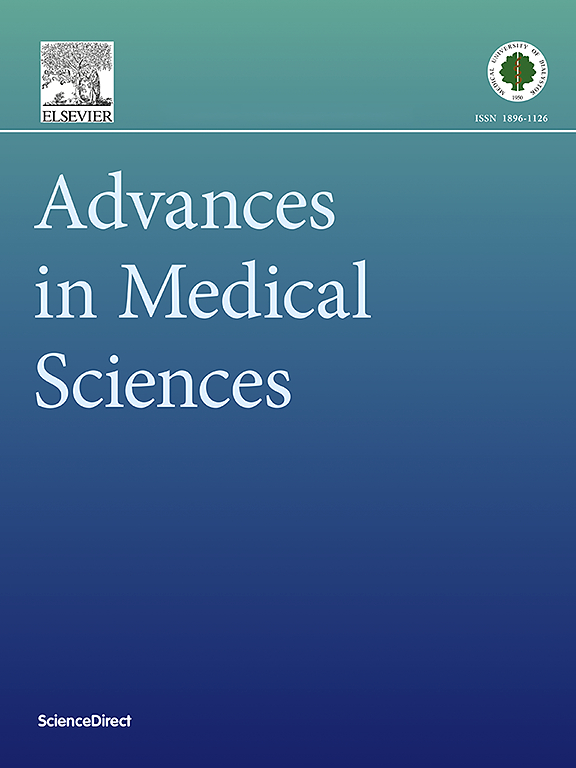Clinical determinants and long-term survival in heart failure with supra-normal ejection fraction. Insights from LECRA-HF registry
IF 2.5
4区 医学
Q3 MEDICINE, RESEARCH & EXPERIMENTAL
引用次数: 0
Abstract
Purpose
Heart failure with supra-normal ejection fraction (HFsnEF), defined as HF with left ventricular ejection fraction (LVEF) > 65 %, constitutes a novel HF category. However, its clinical characteristics and long-term outcomes remain insufficiently elucidated. We sought to characterize Polish HFsnEF patients and provide their long-term mortality.
Material and methods
Of 1186 patients enrolled in the single-center Lesser Poland Cracovian Heart Failure (LECRA-HF) registry between years 2009 and 2019, 261 (22 %) were classified as HF with LVEF ≥50 %. Of them, 40 (15.3 %) were classified as HFsnEF, and the remaining 221 (84.7 %) as HF with preserved EF (HFpEF). Baseline characteristics, prior cardiovascular treatment, laboratory and echocardiographic measurements have been collected during index hospitalization. The long-term follow-up of all-cause mortality was obtained from the National Death Registry.
Results
HFsnEF patients were less frequently hypertensive (75 vs 88.2 %, P = 0.026) and they were less often treated with mineralocorticoid receptor antagonists (25 vs 46.2 %, P = 0.013) and loop diuretics (60 vs 76 %, P = 0.017). The Kaplan-Meier analysis showed that all-cause mortality is higher in HFsnEF than in HFpEF (65 vs 55.2 %, P = 0.044). The independent predictors of long-term mortality were age and HFsnEF diagnosis (hazard ratio [HR] 1.037, 95 % confidence interval [CI] 1.018–1.056; HR 1.665, 95 % CI 1.063–2.608, respectively).
Conclusions
Our findings indicate that every 7th Polish patient admitted with HFpEF could be classified as HFsnEF. Baseline characteristics of HFsnEF patients are not significantly different from HFpEF. Simultaneously, in the longest follow-up to date, HFsnEF diagnosis is associated with lower long-term survival.

射血分数超常心力衰竭的临床决定因素和长期生存。来自LECRA-HF注册表的见解。
目的:心力衰竭伴超正常射血分数(HFsnEF),定义为左室射血分数(LVEF)低于65%的HF,是一种新的HF类别。然而,其临床特征和长期结果仍不充分阐明。我们试图描述波兰hfsnf患者的特征,并提供他们的长期死亡率。材料和方法:2009年至2019年,在单中心小波兰克拉科夫心力衰竭(LECRA-HF)登记的1186例患者中,261例(22%)被归类为心力衰竭,LVEF≥50%。其中HFsnEF 40例(15.3%),保留EF (HFpEF) 221例(84.7%)。基线特征,既往心血管治疗,实验室和超声心动图测量收集在索引住院期间。全因死亡率的长期随访来自国家死亡登记处。结果:HFsnEF患者高血压发生率较低(75 vs 88.2%, P=0.026),矿皮质激素受体拮抗剂(25 vs 46.2%, P=0.013)和循环利尿剂(60 vs 76%, P=0.017)的发生率较低。Kaplan-Meier分析显示HFsnEF的全因死亡率高于HFpEF (65% vs 55.2%, P=0.044)。长期死亡率的独立预测因素为年龄和HFsnEF诊断(风险比[HR] 1.037, 95%可信区间[CI] 1.018-1.056;HR为1.665,95% CI为1.063-2.608)。结论:我们的研究结果表明,每7例入院的波兰HFpEF患者中就有1例可归类为HFsnEF。HFsnEF患者的基线特征与HFpEF患者无显著差异。同时,在迄今为止最长的随访中,HFsnEF诊断与较低的长期生存率相关。
本文章由计算机程序翻译,如有差异,请以英文原文为准。
求助全文
约1分钟内获得全文
求助全文
来源期刊

Advances in medical sciences
医学-医学:研究与实验
CiteScore
5.00
自引率
0.00%
发文量
53
审稿时长
25 days
期刊介绍:
Advances in Medical Sciences is an international, peer-reviewed journal that welcomes original research articles and reviews on current advances in life sciences, preclinical and clinical medicine, and related disciplines.
The Journal’s primary aim is to make every effort to contribute to progress in medical sciences. The strive is to bridge laboratory and clinical settings with cutting edge research findings and new developments.
Advances in Medical Sciences publishes articles which bring novel insights into diagnostic and molecular imaging, offering essential prior knowledge for diagnosis and treatment indispensable in all areas of medical sciences. It also publishes articles on pathological sciences giving foundation knowledge on the overall study of human diseases. Through its publications Advances in Medical Sciences also stresses the importance of pharmaceutical sciences as a rapidly and ever expanding area of research on drug design, development, action and evaluation contributing significantly to a variety of scientific disciplines.
The journal welcomes submissions from the following disciplines:
General and internal medicine,
Cancer research,
Genetics,
Endocrinology,
Gastroenterology,
Cardiology and Cardiovascular Medicine,
Immunology and Allergy,
Pathology and Forensic Medicine,
Cell and molecular Biology,
Haematology,
Biochemistry,
Clinical and Experimental Pathology.
 求助内容:
求助内容: 应助结果提醒方式:
应助结果提醒方式:


